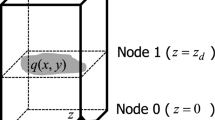Abstract
The coupling between a cavity and a vibrating plate is written as a strong coupling where both the continuity of stresses and particle velocities at the interface are taken into account. A FEM analysis reveals an important coupling between the first mode of the plate and the cavity. The pressure distribution in the cavity shows a strong quarter of a wave length pattern indicating the influence of the first Dirichlet mode in the cavity.
The vibrating plate is then excited by a turbulent flow modelled by its spectral density using the Corcos model. A comparison is made between the results obtained from a FEM and a BEM formulation. Good agreements are observed concerning the plate displacements. The comparison of the cavity sound pressure levels is less good.
Similar content being viewed by others
References
Chase, D.M., Modeling the wavevector-frequency spectrum of turbulent boundary layer wall pressure. Journal of Sound and Vibration 70 (1980) 29–67.
Chase, D.M., The character of the turbulent wall pressure spectrum at subconvective wavenumbers and a suggested comprehensive model. Journal of Sound and Vibration 112 (1987) 125–147.
Chase, D.M., The wave-vector-frequency spectrum of pressure on a smooth plane in turbulent boundary-layer flow at low Mach number. Journal of the Acoustical Society of America 90 (1991) 1032–1040.
Craggs, A., The transient response of a coupled plate-acoustic system using plate and acoustic finite elements. Journal of Sound and Vibration 15 (1971) 509–528.
Dhainaut, M., Finite Element procedures for fluid-structure interactions in acoustics. Doctoral Thesis, Report No. 429612, The Norwegian University of Science and Technology, Trondheim, Norway (1996).
Dhainaut, M., A comparison between Serendipity and Lagrange plate elements in the Finite Element Method. International Journal for Numerical Methods in Engineering 13 (1997) 343–353.
Howe, D.M., Surface pressure and sound produced by turbulent flow over smooth and rough walls. Journal of the Acoustical Society of America 90 (1991) 1041–1047.
Koh, S.H. and Nuttall, A.H., Analytical evaluation of flush-mounted hydrophone array response to the Corcos turbulent wall pressure spectrum. Journal of the Acoustical Society of America 90 (1991) 579–588.
Mazzoni, D., Sur la modélisation du rayonnement acoustique de sources aléatoires: Problème direct et problème inverse. Doctoral Thesis, Report No. 2079448, Institut de Mécanique de Marseille, Université Aix-Marseille II, France (1994).
Petyt, M. and Lim, S.P., Finite element analysis of the noise inside a mechanically excited cylinder. International Journal for Numerical Methods in Engineering 13 (1978) 109–122.
Rights and permissions
About this article
Cite this article
Dhainaut, M., Kristiansen, U.R. & Filippi, P.J. Sound Radiated in a Cavity by a Vibrating Plate: Comparison between the Results of a Finite Element Method (FEMAK) and a Boundary Element Method (NoVAlea2D). Flow, Turbulence and Combustion 61, 43–53 (1998). https://doi.org/10.1023/A:1026487315387
Issue Date:
DOI: https://doi.org/10.1023/A:1026487315387




